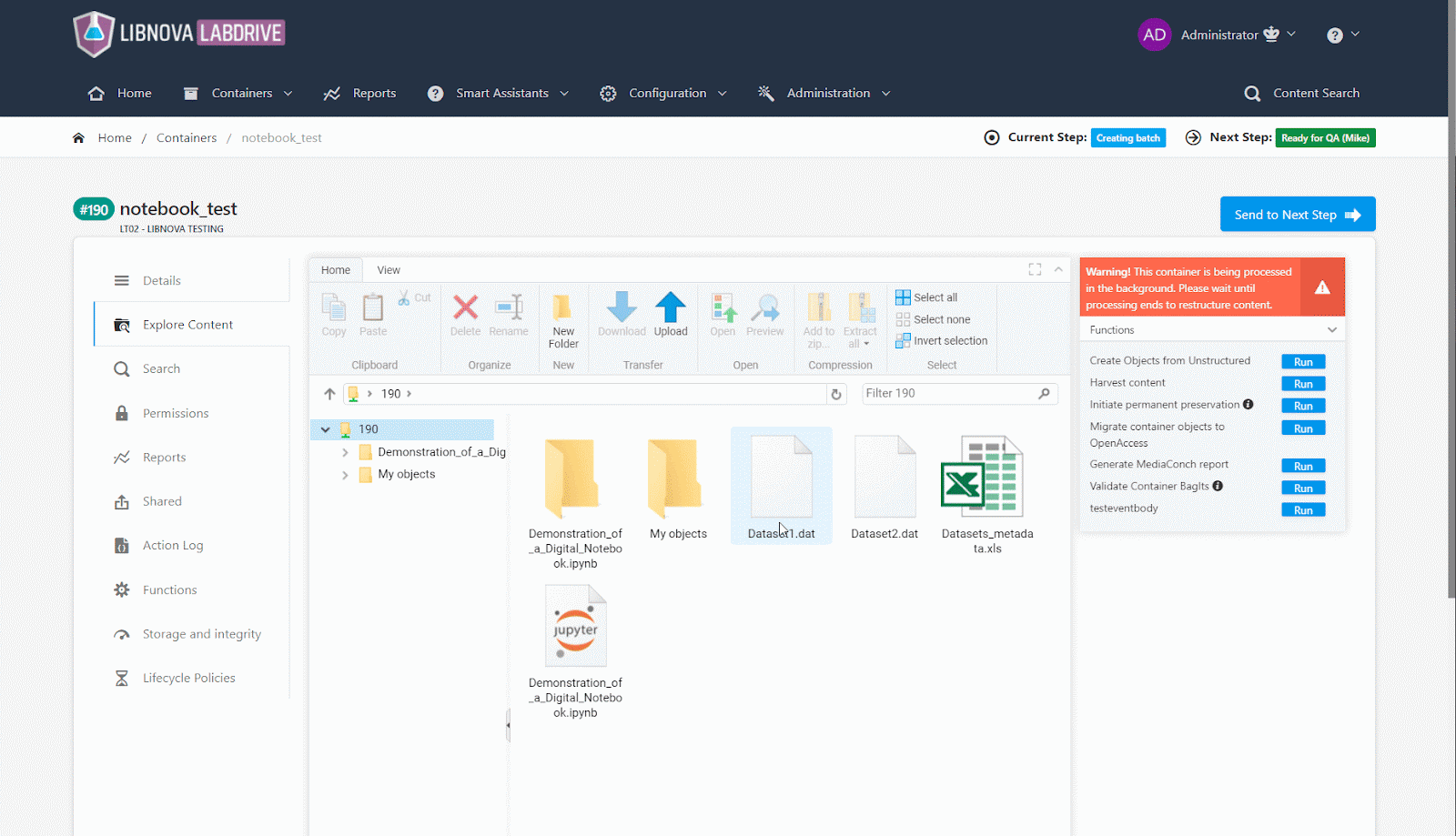Antonio Guillermo Martinez is the CEO and founder of LIBNOVA.
Este blog está disponible en español a continuación:
Last year, in our guest post on the DPC blog we wrote about the challenges of the digital preservation of research datasets, and unknowingly it was slightly related to this year's chosen topic: Breaking Down Barriers.
This year, we want to focus on some of the technological barriers that LIBNOVA has broken down to make digital preservation more accessible to the community by simplifying it.
Historically, digital preservation systems have been complex to use and complex to set up. When we first met this community, everything was complicated, everything was difficult to do. LIBNOVA has focused every single day since its inception on breaking down those barriers, empowering the community to do more with less, and optimizing its systems to help them achieve that.
One of our main goals remains to offer easy-to-use digital preservation systems that, while following good digital preservation practices, allow to achieve the highest level of digital preservation (NSDA 4/4), with basic digital preservation knowledge and a low learning curve to use the platform.
These are some examples of the barriers we have broken in the technological field of software development, making digital preservation accessible to our entire community, and allowing people to do things for themselves, aided by technology:
Streamlined drag and drop ingestion process
Through our disruptive technology, we have transformed the complex manual process of creating submission information package workflows into a simple "Drag and Drop" action that can even be automated. With LIBSAFE, information does not need to be structured in order to be preserved, which facilitates faster content ingestion.

Automated metadata generation
By applying Artificial Intelligence and Machine Learning techniques, we have succeeded in automatically classifying digital objects during the ingest process. In addition, LIBSAFE technology is able to automatically extract the technical information that accompanies the digital object and add it as metadata fields in the preservation system. Not only is the software also able to detect who appears or who speaks in a video (RNN - Recurrent Neural Network) or audio (HMM - Hidden Markov Models) file, but it can add their names to the object's metadata automatically, and it is possible to use SRT files for subtitling videos.
This allows time-consuming repetitive tasks to be automated, allowing information professionals to spend that time on much more valuable tasks. So, again, doing more with less.
Digital preservation of endangered historical monuments
For some years now, we have been fortunate to be the technological partners of a non-profit organization that deals with the digital archiving of cultural heritage from all over the world, especially the ones that are in danger of being destroyed forever. Using photogrammetry, their strategy consists of making 3D models of unique objects, monuments, buildings and landscapes. As a result of these "reality sampling" techniques and technologies, a 3D-point cloud of hundreds of thousands of individual measurements in a coordinate system (x, y, z) is obtained, which can be used to form a three-dimensional model of the objects.
Not only they use LIBSAFE's technology for the digital preservation of these complex digital objects, but they also use our dissemination solution to make their digital collections accessible to humanity. Thanks to their eagerness to preserve history, from their website https://collections.arck-project.org/ it is possible to take a virtual tour of the now-destroyed Palmyra Castle (damaged during the Syrian Civil War), to see a virtual recreation of Neil Armstrong on the Moon's surface, or to 3D view in full detail the olive-green draped Givenchy dress that costume designer Sindy Powell wore on the red carpet in 2012, among many other things.
Continue breaking down barriers
Keeping LIBNOVA at the forefront of preservation, with a firm commitment to research that allows us to push the boundaries of what is possible in digital preservation, means that more and more world-class institutions are joining our community of users, which already includes renowned organizations such as the British Library, the University of Oxford, the HILA at Stanford University, the Holocaust Memorial Museum of the United States, the National Library of Spain or the EPFL, just to name a few.
Derribar Barreras como parte de nuestro ADN
El año pasado, en nuestro post como invitados en el blog de la DPC escribimos sobre los desafíos que supone la preservación digital de los datos de investigación, y, sin saberlo, ya estaba un poco relacionado con el tema elegido para este año: Derribando Barreras.
Este año, queremos centrarnos en algunas de las barreras tecnológicas que ha derribado LIBNOVA para hacer la preservación digital más accesible para la comunidad, simplificándola.
Los sistemas de preservación digital han sido históricamente complejos de utilizar y complejos de configurar. Cuando nosotros conocimos esta comunidad todo era complicado, todo era difícil. LIBNOVA se ha centrado día a día, desde sus inicios, en derribar esas barreras, hacer que la comunidad pueda hacer más con menos, y optimizar sus sistemas para que les ayuden a conseguirlo.
Uno de nuestros objetivos principales sigue siendo ofrecer sistemas de preservación digital fáciles de utilizar, que, siguiendo las buenas prácticas de preservación digital, permitan alcanzar el máximo nivel de preservación digital (NSDA 4/4), con unos conocimientos básicos de preservación digital y una baja curva de aprendizaje a la hora de utilizar la plataforma.
Estos son algunos ejemplos de las barreras que hemos derribado en el ámbito tecnológico del desarrollo de software haciendo que la preservación digital sea accesible para toda nuestra comunidad, y permitiendo que, ayudados por la tecnología, las personas sean capaces de hacer cosas por sí mismas:
Optimización del proceso de ingesta (Arrastrar y Soltar)
Gracias a nuestra disruptiva tecnología, hemos transformado el complejo proceso manual de creación de flujos de trabajo de paquetes de envío de la información en un simple gesto de “Arrastrar y Soltar” que incluso puede ser automatizado. Con LIBSAFE no es necesario que la información esté estructurada para que pueda ser preservada, lo que facilita la ingesta de contenidos de forma más rápida.

Generación automática de metadatos
Aplicando técnicas de Inteligencia Artificial y Machine Learning, hemos conseguido que durante el proceso de ingesta se pueda clasificar de manera automática los objetos digitales. Además, la tecnología de LIBSAFE tiene capacidad para extraer automáticamente la información técnica que acompaña al objeto digital y añadirla como metadatos en el sistema de preservación. Pero no solo eso, sino que el software también es capaz de detectar quién aparece o quién habla en un archivo de vídeo (RNN – Recurrent Neural Network) o de audio (HMM – Hidden Markov Models) y puede añadir sus nombres a los metadatos del objeto automáticamente, y también es posible usar archivos SRT para agregar subtítulos a los vídeos.
De este modo, es posible automatizar tareas repetitivas que consumen mucho tiempo permitiendo a los usuarios (profesionales de la información) dedicar ese tiempo a tareas mucho más valiosas. De nuevo, hacer más con menos.
Preservación digital de monumentos históricos ya desaparecidos
Desde hace algunos años tenemos la suerte de ser los socios tecnológicos de una organización no gubernamental que se ocupa de archivar digitalmente el patrimonio cultural de todo el mundo, especialmente aquello que está en peligro de ser destruido para siempre. Su estrategia consiste en realizar modelos 3D de objetos, monumentos, edificios y paisajes singulares a partir de fotogrametrías. Como resultado de estas técnicas y tecnologías del “muestreo de realidad” se obtiene una nube de puntos 3D compuesta por cientos de miles de mediciones individuales en un sistema de coordenadas (x, y, z), a partir de la cual se puede formar un modelo tridimensional de los objetos.
Además de utilizar la tecnología de LIBSAFE para preservar digitalmente estos complejos objetos digitales, también utilizan nuestra solución de difusión para hacer accesible a la humanidad sus colecciones digitales. Gracias a su afán por preservar la historia, desde su web https://collections.arck-project.org/ se puede realizar una visita virtual por el ya desaparecido Castillo de Palmira (destruido durante la Guerra Civil de Siria), ver una recreación virtual de Neil Armstrong en la superficie lunar, o ver en 3D con todo detalle el vestido drapeado verde oliva de Givenchy que la diseñadora de vestuario Sindy Powell usó en la alfombra roja en 2012, entre otras muchas cosas.
Continuar rompiendo barreras
Mantener LIBNOVA a la vanguardia de la preservación, apostando firmemente por la investigación que nos permita ampliar los límites de lo que es posible en la preservación digital, hace que cada vez más instituciones de primer nivel mundial se unan a nuestra comunidad de usuarios, en la que ya se encuentran organizaciones como la British Library, la Universidad de Oxford, la HILA Stanford University, el Museo del Holocausto de Estados Unidos, la Biblioteca Nacional de España o la EPFL, entre muchos otros.
